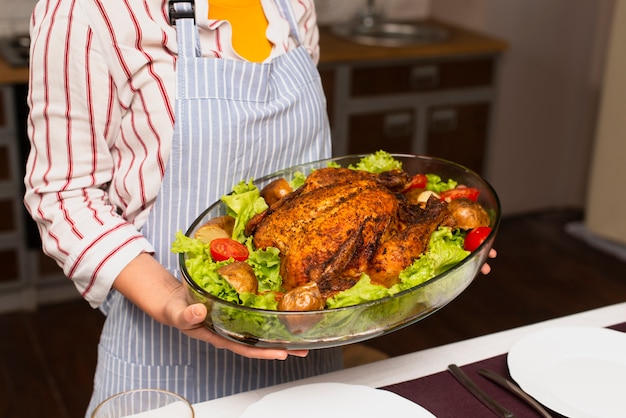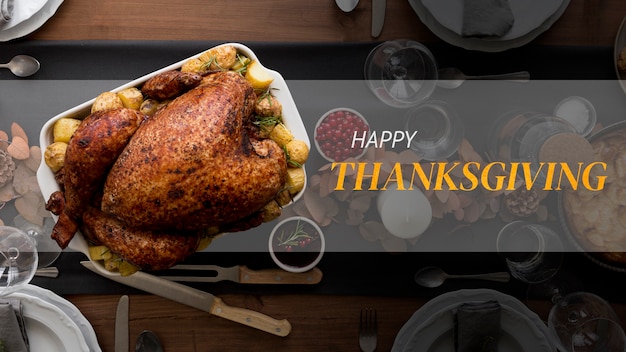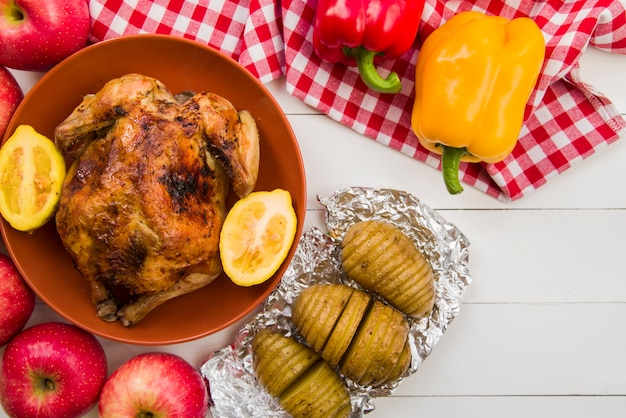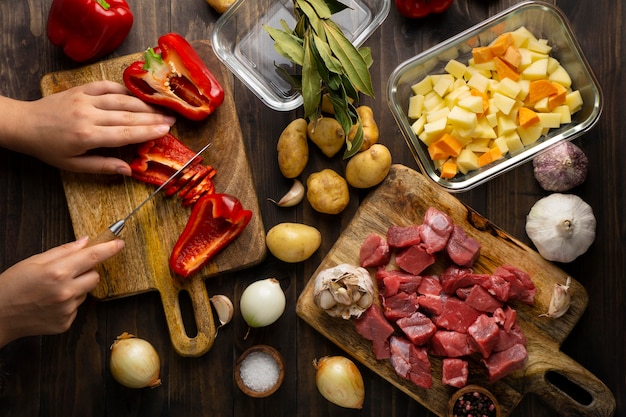Ah, the turkey. A symbol of feasts, family gatherings, and that special kind of holiday magic. But let's be real, folks, cooking a big bird like that can feel like a monumental task. I've been there, staring at the clock, wondering if that turkey will ever be done. Over the years, I’ve roasted countless turkeys, from small, intimate family gatherings to full-on Christmas feasts. Each one has been a learning experience, and I’ve picked up a few tips and tricks along the way. So, if you're wondering how long it takes to roast a 14-pound turkey, you've come to the right place. I'm going to break it down for you, step-by-step, from prepping the bird to checking for doneness. We'll delve into the importance of a well-roasted turkey, the art of prepping and trussing, the best roasting techniques, and even some insider tips for achieving turkey perfection. Get ready, because we're about to dive into the world of turkey roasting!
(Part 1) The Importance of a Well-Roasted Turkey

Think about it. A perfectly roasted turkey is the centerpiece of any holiday feast. It’s the dish that everyone gathers around, the one that brings the family together. It’s that delicious aroma that fills the house, and the warmth that radiates around the table. A well-roasted turkey is more than just a meal; it’s an experience. It's a symbol of a successful gathering, a testament to your culinary prowess, and a delicious treat that everyone can enjoy. Imagine everyone carving into that juicy, golden-brown bird, savouring every bite. That’s what we’re aiming for!
But a dry, overcooked turkey can be a real let-down. It’s like a missed goal in a big match - you've put in the effort, but you haven't quite hit the mark. It’s a bit of a bummer, to say the least. The disappointment is palpable, and it can dampen the festive mood. Nobody wants to be faced with a tough, dry turkey. That’s why a well-roasted turkey is so important. It’s a triumph, a symbol of victory over culinary challenges, and a testament to your skill as a cook.
(Part 2) Prepping Your Turkey

Getting Started
Let’s start by getting your turkey ready for the oven. It’s a little like getting a football team ready for the big game - you need to get them prepped and in the right position for success. I always begin by removing the turkey from its packaging and giving it a good rinse under cold water. It’s a good idea to remove any giblets and neck from the cavity too – they’ll be handy for making gravy later. Next, I pat it dry with paper towels. This removes any excess moisture and helps the skin get crispy. You know, that perfect, golden-brown skin that everyone craves. It’s a crucial part of the turkey experience, a satisfying contrast to the juicy meat beneath.
Stuffing Time
Now, let’s talk about stuffing. Some people swear by stuffing their turkey, while others prefer to cook it separately. It’s a matter of personal preference. I'm a firm believer in stuffing the turkey, but I do it loosely. You don't want to cram it in there because it needs room to cook properly. Remember, stuffing should be cooked to a safe temperature of 165°F, just like the turkey. If you're stuffing the turkey, I recommend cooking it at a lower temperature than usual to give the stuffing time to cook through. You can also bake the stuffing separately, which is a good option if you're worried about it getting too dry inside the turkey.
Seasoning
Next up, seasoning. This is where the real fun begins. I like to keep it simple with salt, pepper, and herbs, but you can add other seasonings like garlic powder, onion powder, or even paprika for a bit of colour. Don’t be afraid to experiment with different blends! Whatever you choose, rub it all over the turkey, making sure to get under the skin. This will help the seasoning permeate the meat and give it a lovely flavour. You can also try injecting the turkey with a brine or butter solution, which can add extra moisture and flavour.
The Trussing Technique
Now, for the trussing. Trussing a turkey means tying its legs and wings together to keep it compact and prevent it from drying out. It also helps the turkey cook evenly and ensures that the breast meat doesn’t get overcooked. You can truss your turkey with string or use a special turkey trussing tool. I personally find string easier to use, and it doesn’t require any special tools. You just need to tie the legs together, then fold the wings back and tie them to the body of the turkey. It’s a little like giving the turkey a hug, keeping everything nice and snug.
(Part 3) Roasting Your Turkey

Choosing the Right Pan
Alright, so your turkey is prepped and ready to go. The next step is to find the right roasting pan. You'll need a pan that's big enough to hold your turkey comfortably without it touching the sides. You don't want the turkey to get stuck or steam up, so make sure there's enough space for air to circulate. And don't forget the roasting rack! It will keep the turkey lifted off the bottom of the pan, allowing heat to circulate evenly around it. Think of it as a little bed for your turkey, allowing it to rest comfortably while it cooks.
Getting the Temperature Right
Now, onto the oven. Preheat your oven to 325°F (165°C). This is the perfect temperature for a 14-pound turkey. It will cook slowly and evenly, resulting in a juicy and flavorful bird. You want to give it time to cook, let the heat do its thing, and slowly transform the turkey into a culinary masterpiece.
Calculating cooking time
Here's where things get interesting. The cooking time for a 14-pound turkey is about 3-4 hours. But that's just a general guideline. You need to consider a few factors:
- The turkey’s weight: A 14-pound turkey will take longer to cook than a smaller turkey. The heavier the turkey, the longer the cooking time.
- The stuffing: If you’re stuffing your turkey, it will need extra time to cook. stuffed turkeys often take a bit longer to reach the desired temperature.
- Your oven: Some ovens cook hotter than others, so you might need to adjust the cooking time accordingly. The temperature of your oven can influence the cooking time, so it’s important to be aware of its quirks.
(Part 4) The Importance of Checking for Doneness
The Importance of a meat thermometer
Okay, so your turkey is in the oven. But how do you know when it's done? You can’t just go by the time alone. You need a meat thermometer! I always use a digital meat thermometer because it gives me an accurate reading. You want to make sure that the turkey has reached an internal temperature of 165°F in the thickest part of the thigh. This ensures that the turkey is cooked through and safe to eat.
The Turkey’s Temperature
It’s important to take the turkey’s temperature in different places. Don’t just check the thigh. Check the breast, too. You want to make sure that the whole turkey is cooked through and that there are no cold spots. The breast meat tends to cook faster than the thighs, so you need to make sure that both areas are cooked properly.
How to Rest the Turkey
Once the turkey has reached the desired temperature, take it out of the oven and let it rest for 15-20 minutes before carving. This allows the juices to redistribute, resulting in a more tender and flavorful turkey. Think of it as giving the turkey a chance to relax and recover after its long journey in the oven.
(Part 5) Dealing with Overcooked Turkey
Recognising the Signs
We all make mistakes, and sometimes, even the most experienced cooks can overcook their turkey. If you've overcooked your turkey, you'll likely notice that the breast meat is dry and tough. It might also be a bit discoloured, with a greyish hue. It’s a bit of a culinary tragedy, but don’t despair, there are still ways to salvage the situation.
Remedies for Overcooked Turkey
Don't despair! There are a few things you can do to salvage an overcooked turkey. First, you can try to rehydrate it by adding some broth or gravy. You can also try to make the meat more tender by shredding it and using it in a casserole or other dish. Turn that overcooked turkey into a delicious turkey casserole, or use it in a hearty turkey soup.
Preventing Overcooked Turkey
The best way to avoid overcooked turkey is to check its temperature regularly and take it out of the oven when it reaches the desired temperature. You can also try to reduce the cooking time by 15-20 minutes to prevent overcooking. It’s better to err on the side of caution and undercook slightly than risk overcooking your turkey.
(Part 6) Mastering the Art of Carving
Preparation is Key
You’ve got your turkey out of the oven, it’s rested, and now it’s time to carve. First, let’s set up. Make sure you have a carving board or tray, a sharp knife, and a pair of kitchen tongs. I always like to put a bit of paper towel on the carving board to absorb any excess juices. It also helps keep your carving board clean. This is a crucial step, as it’s a bit like setting the stage for the grand finale.
The Process of Carving
Now, let's get to the carving. Start by cutting off the wings and legs. Then, you can carve the breast meat into slices. If you're feeling adventurous, you can try to bone out the breast to make it easier to carve. Just be careful! This is a skill that takes practice, so don’t be afraid to experiment. If you’re not sure how to bone out the breast, there are plenty of videos online that can walk you through the process.
Serving the Turkey
Once the turkey is carved, it's time to serve it up. I like to arrange the meat on a platter, garnished with parsley or rosemary for a touch of elegance. You can also add some cranberries, pomegranate seeds, or even some fresh herbs for a festive touch.
(Part 7) Serving Your Masterpiece
Presentation is Everything
Presentation matters. I always like to make my turkey platter look inviting. I’ll add some festive touches like cranberries, pomegranate seeds, or even some fresh herbs. It's like putting on a culinary show, creating a visually appealing experience for your guests. I also like to serve the turkey with sides like mashed potatoes, gravy, and stuffing. A splash of colour makes all the difference, trust me.
Accompaniments and Sides
What goes well with roast turkey? That’s a question for the ages. But I’m a sucker for classic combinations. I like to serve it with gravy, stuffing, cranberry sauce, and mashed potatoes. It’s a combination that never fails. You can also add some roasted vegetables, like Brussels sprouts or carrots, for a touch of sweetness and colour.
(Part 8) Making the Most of Leftovers
Saving the Best for Last
Ah, leftovers. The best part of the whole turkey roasting experience. There’s something magical about leftover turkey. It's just as delicious the next day, if not more so. The flavours have had a chance to meld, and the meat is even more tender. It’s a culinary treasure that deserves to be savoured.
Tasty Leftover Ideas
I’m always looking for new ways to use leftover turkey. My favourite is turkey sandwiches on sourdough bread with a dollop of cranberry sauce and a bit of mayonnaise. But you can also make turkey soup, turkey pot pie, or even turkey salad. Get creative, the possibilities are endless.
Storing Leftovers
Storing leftovers is important. I always make sure to refrigerate my leftover turkey as soon as possible. I'll put it in an airtight container to prevent it from drying out. You can store leftover turkey in the refrigerator for up to 4 days.
(Part 9) Tips and Tricks from a Veteran
Don’t Forget the Butter
I always like to rub the turkey with butter before roasting it. This helps the skin get crispy and adds a lovely flavour to the meat. The butter creates a protective barrier, preventing the turkey from drying out and enhancing its flavour.
The Power of Brining
Brining is a technique that involves soaking the turkey in a salt water solution for several hours before roasting. This helps keep the turkey moist and flavorful. I don't always brine, but when I do, it's a game-changer. It adds a depth of flavour that’s hard to beat.
Using a Roasting Bag
Roasting bags are a great way to keep your turkey moist and juicy. They trap the steam inside, making for a tender and flavorful bird. It's like a little oven inside an oven, creating a perfect environment for your turkey to cook.
(Part 10) FAQs about roasting turkey
1. How do I tell if my turkey is done?
The best way to tell if your turkey is done is to use a meat thermometer. Insert the thermometer into the thickest part of the thigh, making sure it doesn't touch any bone. The turkey is done when the internal temperature reaches 165°F (74°C). This is the gold standard for ensuring that your turkey is cooked through and safe to eat.
2. What should I do if my turkey is overcooked?
If your turkey is overcooked, it will likely be dry and tough. You can try to rehydrate it by adding some broth or gravy. You can also try to make the meat more tender by shredding it and using it in a casserole or other dish. Sometimes, the best way to salvage an overcooked turkey is to turn it into something new and delicious.
3. How long should I rest my turkey before carving?
You should rest your turkey for 15-20 minutes before carving. This allows the juices to redistribute, resulting in a more tender and flavorful turkey. Giving the turkey a chance to rest is like allowing the flavours to settle and become even more delicious.
4. Can I freeze leftover turkey?
Yes, you can freeze leftover turkey. Wrap it tightly in plastic wrap or aluminum foil and store it in the freezer for up to 2 months. Freezing leftovers allows you to enjoy the deliciousness of your turkey long after the feast is over.
5. What’s the best way to cook a turkey?
The best way to cook a turkey is to roast it in the oven. This method produces a juicy and flavorful bird. You can also try other methods, such as grilling or smoking, but roasting is the most traditional and reliable method. Roasting in the oven allows the heat to circulate evenly, resulting in a perfectly cooked turkey.
roasting a turkey can be a little daunting, but with the right approach and a little patience, you can create a truly delicious and impressive dish. And remember, it’s all about the journey, not just the destination. So, enjoy the process, and don't be afraid to experiment! Who knows, you might just discover a new turkey-roasting technique that becomes a family favourite. Happy cooking, everyone!
Everyone is watching

Perfect Rice Every Time: The Ultimate Guide to Cooking Rice
Cooking TipsAs a self-proclaimed foodie, I've always been a bit obsessed with rice. It's the foundation of countless cuisi...

Ultimate Guide to Cooking the Perfect Thanksgiving Turkey
Cooking TipsThanksgiving. Just the word conjures up images of overflowing tables laden with delicious food, the scent of r...

The Ultimate Guide to Cooking Asparagus: Tips, Techniques, and Recipes
Cooking TipsAsparagus. The mere mention of this spring delicacy conjures up images of vibrant green spears, crisp and burs...

Can You Cook Spaghetti with Gasoline? (The Shocking Truth)
Cooking TipsWe've all seen those crazy internet trends. You know, the ones that make you wonder, "Did someone actually try...

Chorizo and Eggs Recipe: The Ultimate Guide
Cooking TipsRight, let’s talk about chorizo and eggs. You know, that classic Spanish dish that's always a winner. It's th...
